How Do You Know When a Goat Is in Labor
Reproduction
Doe
| Age of attainment of puberty: | 7 months to 1 twelvemonth |
| Gauge weight at first mating: | 15-18 kg |
| Age at outset mating or insemination: | eight months to 12 months |
| Oestrous cycle : | Generally every 18-21 days |
| Elapsing of heat: | fourteen – 48 hours |
| Gestation flow: | 145 – 156 days |
| Age at showtime kidding: | 13 –17 months |
| Ideal kidding rate: | 3 in 2 consecutive years |
| Service catamenia : | 45 days |
| Minimum dry period : | 30 days |
Signs of rut
- Wagging of tail. The frequency of tail movement increases in the presence of males.
- Frequent bleating, more so when the goat is alone.
- Excitement or restlessness.
- Anorexia and lack of interest in feed.
- Drop in milk yield.
- Vulva becomes swollen and oedematous.
- Small quantity of articulate discharge from the vagina.
- Doe anxiously goes seeking the buck.
- Information technology remains close to the buck and allows mounting.
- It mounts on other goats and allows to be mounted by others.
Buck
A young buck may be selected based on the production functioning of its dam and/or its sisters. Their yield must exist i.5 kg per day. Bucks should be masculine and virile with straight legs and long feet. Preference may exist given to the i in the twins or triplets. Must possess good libido and adept semen quality. While selecting male person goats for meat purpose weight at half-dozen months should non be less than 12 kg. A cadet should be put into service only when it is 10 to 12 months of age.
Age at puberty: five–7 months.
Historic period at which kids of dissimilar sexes should exist separated: 3–v months.
Historic period at which training for semen collection can be started: ix months.
Age upto, which bucks, tin be used for breeding purpose: half-dozen–8 years
Gestation menses
Symptoms at diverse stages of gestation in goats
| Stage of gestation | Cervix | Vagina | Uterus |
| Non pregnant or before 25 days | No tension of the wall | Within pelvic cavity no hypertrophy | Located within pelvic cavity, no clear asymmetry of horns (slightly asymmetric in some of the does), harder consistency. |
| 30 days | -practise- | Inside pelvic cavity | Located at pelvic skirt, clear disproportion of horns with softer and fluid filled consistency. |
| 45 days | Slight stretching of the wall | Located at pelvic brim, slightly hard in consistency only no hypertrophy | Located in front of the pelvic brim, complete retroversion into the pelvic cavity possible. Clear distension of uterus, softer in consistency, horns distinguishable in some cases. |
| 60 days | Stretched frontwards | At pelvic skirt, slightly hypertrophied and soft. | Located in front end of the pelvic brim, complete retroversion possible in most 20% cases, marked distension of uterus, fluid filled consistency, uterine horns indistinguishable. |
| 90 days | Stretched forward | In front of pelvic brim, slightly hypertrophied and softer. | Uterus within intestinal cavity, only posterior aspect of uterus palpable. Internal ballotment of foetus possible in eighty% of the cases, placentome sideslip palpable in xxx%. |
| 120 days | Slight relaxation of vaginal stretching | In front of pelvic brim, large and soft, difficult to palpate in 20% cases | Only posterior aspect of uterus palpable, internal ballotment of foetus possible and placentome sideslip palpable in all cases. Foetal parts and large placentomes palpable in 90% of the animals. |
| 145 days | Slight relaxation of vaginal stretching | In front of pelvic brim, big and soft, difficult to palpate in 20% cases. | Foetal parts palpable inside pelvic and placentomes palpable in 85% of the animals. |
ARTIFICIAL INSEMINATION IN GOATS
| Sterility in males is a major cause equally to why AI needs to be adopted and propagated in goats on a large scale. In Germany and the Netherlands the AI has been adopted on a big scale since 50'southward but it is besides skillful in other countries. Normally a middle-aged cadet donates 1 to three ml of semen, sometimes up to five ml. Just semen quality is normally good when the volume is in 1 to 2 ml range. Semen is white to lemon-cream and varies in viscosity depending on concentration. Motion of proficient spermatozoa is greater than of bull spermatozoa, hence a different movement scoring design is recommended. The sperm count procedure is substantially the same. A minimum concentration of two,000 x 106 spermatozoa per ml of ejaculate effects conception charge per unit. Morphological defects are often seen with caprine animal spermatozoa. Normally ejaculates with less than 10 per cent spermatozoa abnormality are capable of fertilization. Sterility due to semen stasis and hypoplasis of the gonads is as high every bit 25 per cent. This state of affairs is more because of overfeeding than underfeeding. High temperature and humidity bear on the semen quality in goat - bucks. The reaction fourth dimension varies from 63 to 160 seconds and there is seasonally. Though Artificial Vagina method is widely used for semen collection, semen of proficient quality is obtainable through electrical stimulation. Buck semen is very sensitive to cold daze. Yolk — citrate-based extenders are widely used to extend the semen to ane:ten and upward to 1:15 too. Spermasol with yolk (1:6 dilution) and sulpha compounds for antibiotics are used to improve the keeping quality. Speculum is invariably in utilize for AI. The conception rate and the number of inseminations required vary from flavour to season. One to four inseminations are practised. Formulation rate of 93-1 per cent with 3-mean solar day-old semen in spermasol—egg-yolk extender has been reported. Merely normally the quality is not kept up to that time in many cases. At present frozen semen is also being used. | ( Photo source : www.luresext.edu ) |
Preventive measures
We practice preventive measures that volition allow our animals have optimum growth and health performance with the minimum corporeality of our labor and expense. Each breeder must determine what is the near important preventive measures for their situation. The type of preventive measures taken by breeders tin can vary widely co-ordinate to the post-obit:
-
Category of goat business they are pursuing.
-
Type of geography where animals are raised.
-
Type of weather.
-
Amount of grazing space bachelor.
-
Amount of fourth dimension breeder wants to put into working with animals.
Preparing doe
The focus on direction of pregnant does is:
- to ensure the doe stays as salubrious every bit possible throughout the pregnancy and kidding period
- the kids are able to develop properly throughout the pregnancy.
The bones needs tin can be summarized into do, proper diet and preventative wellness management steps.
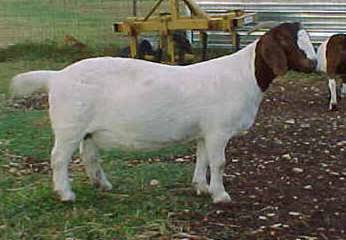
Preparing doe
Exercise
Pregnant does demand to continue every bit much normal activeness every bit possible. They need the forcefulness to carry the extra weight during the final two months and go through the labor successfully. A doe should not come into pregnancy or the first ii months too fat. The normal activity of walking effectually grazing should continue.
Diet
Nutrition is very important in the last two months of pregnancy. lxx % of the weight of the kid(s) is developed from around day 100 to the birthing appointment. Undernourishment during this period will effect in the birth of smaller kids, increased mortality and slower growth rates. A doe in late pregnancy has boosted requirements from their supply of food, especially for free energy foods. As well the uterus and its contents take up a big amount of space in the doe's abdomen so that she cannot eat enough poor-quality foodstuff to provide all of their requirements. The doe's trunk is designed to ensure that the kids get enough free energy food at the expense of her own tissues. Her body will rob her ain reserves to provide diet to the kids.
A doe's appetite often drops off at this time and the book of the uterus contents and the internal fat stored will limit the book of feed she can consume. Therefore the quality of feed must be increased. High quality hay should be fed during this period. Goats that swallow a lot of hay during pregnancy maintain that ability to ingest increased levels of roughage during lactation.
Concentrate food with higher levels of poly peptide can be fed to the does. Y'all do non want to but feed higher levels of concentrate feed. High volumes of concentrate feed has been associated with slow birthing and poor cervical dilations. We feed our meaning does a concentrate feed with 16-17% poly peptide level. Ensure the does accept access to trace-mineralized table salt and clean water.
Preventive Management
-
De-worm the does effectually i month prior to birthing
-
Vaccinate for Clostridium perfringens C and D and tetanus toxoid should be given not less than 3 weeks prior to kidding.
Signs of labor
Nosotros try to be with each of our does that are most to child to lend a hand if there are whatever problems. Nosotros are with our does kidding 85-xc% of the fourth dimension. The only reason we are non with 100% of them is because they kidded during the middle of the night and we did not read the signs of eminent labor. If we see the signs, nosotros will be with them during the middle of the night. Below is some of the type of signs to help you ameliorate understand when your doe is about to kid.
Calendar - We exercise individual convenance of our does. They are placed with a specific buck when the doe comes into heat. We will get out the doe with the buck for two days and so remove them. We certificate the date the doe was serviced. From that date, we will start to closely watch the doe around 149 days from the convenance date.
Tail Dropping - As the doe gets shut to kidding time, her torso will showtime to suit to let the pelvic bones to spread out. Look at the dorsum bone of the goat every bit it connects to the tail surface area. Either side of the tail bone will indent showing the body is getting ready. The moving-picture show to the right was taken eight days before she kidded. This is non the best sign. Information technology is not very specific and sometimes we just don't encounter the tail dropping.
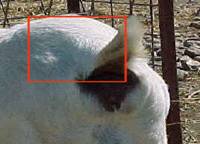
Losing Plug - Our vet calls this "losing their plug". You volition see a small-scale amount of flossy jell leaking from the vulva. The picture to the right was taken at the same time every bit the moving-picture show for the tail dropping, 8 days before she really kidded. We have seen small drippings similar this up to two weeks prior to the doe kidding, therefore this is not a very practiced timing signal unless information technology changes into "streaming". Streaming will be discussed subsequently.
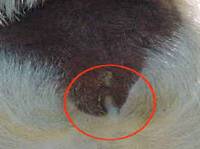
Purse Strutting - This is one of the better signs for estimating eminent labor. The top flick was taken eight days prior to kidding and the bag looks full but the skin is not a shiny texture similar the bottom picture. When the pocketbook is strutted, the skin is as tight as information technology can get and the skin will be very shiny. The clay on the pocketbook in the lesser picture is not part of the strutted sign. That is coming from some other sign, "streaming", which will be discussed after. The bottom film was taken 2 hours before she went into labor. The bag inverse from looking like the peak picture to the bottom picture in virtually 3 hours. We have had a few does that did not have a strutted bag prior to kidding. The purse filled up after kidding, but that is not the norm. When we meet the purse become strutted like the lesser movie, we expect labor to exist very soon and volition start to watch for three other signs...streaming, doe going off by herself, and soft talking by the doe.
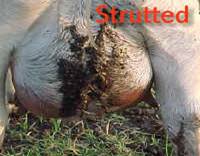

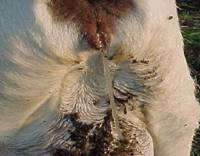
Streaming - This is an extension of the "losing the plug". The difference is in the amount of creamy mucus coming from the doe. This film was taken at the same time as the "bag strutting" picture which was two hours before labor started. You tin see the big amount of mucus streaming from the doe is what caused all of the muddy dirt on the bag. One hour earlier, there had been non streaming similar this. It had looked similar to the "losing the plug" sign. When we see streaming similar this, nosotros expect the doe to first labor within iv-five hours at least. We have seen does stream like this for several days and not go into labor and we get concerned when this occurs. Particularly if the mucus changes to a strawberry color. That is normally a sign that something is wrong with the kids inside.
I desire to be alone - When we run into a doe going off by herself, we get our kidding tools prepare. We expect labor within 4-5 hours at least .Especially if we have seen strutting and streaming.
Soft Talking - Some other certain sign of eminent labor is when the doe starts baaing very soft. This is a unlike sound than she normally makes and much softer. She will as well be looking back at her tum quite ofttimes and tin can't find a comfortable place to stand or lay. We await labor within 4-v hours at least.
Pawing the ground - The doe will start pawing the ground like she is trying to clear a place for kidding.
Labor and kidding
In order to know if a doe's labor is going normal, y'all need to observe does kidding. The following are a general step that does go through in a normal delivery.
Initial Labor
One should have to identify the initial labor when the doe starts labor pushes. Exercise certificate the offset for later evaluation if things are progressing ok. Lookout the vulva during the labor pushes to run into if it is trying to open up up and extend outward. Information technology is extended and opening upwards. There may be a dark colored chimera, 3-v inches in diameter, initially come out and erupt with liquid being released. In some births have no chimera comes out.
Potential Problems
If the doe continues to have labor pushes for 1-2 hours and the vulva does not show signs of extending and trying to open up, we consider there is a problem with the child being able to come out properly. They may non be positioned properly or the neck may non have expanded sufficiently to allow the child to enter the birth cannel. It is likely that someone, (vet or you if you lot know what you are doing) may have to go inside to help. A vet may have to do a C-department to deliver the kids.

If the streaming fungus is or turns strawberry red colour, there may exist problems with the kids.There are several does have this and the results ended up being the kids were already dead.
H2o Bubble
1 of the outset activities of kidding can exist a transparent bubble protruding that contains liquids. This does not always occur but is a normal process in the birthing. The doe volition go into labor doing pushes and groaning. This transparent bubble will start to announced. She may go up and down during this period. Eventually it will burst and the doe will likely potable some of this liquid. A similar bubble may come up out with the kid inside. If this is the bag with the kid within, you will be able to see within the chimera and one or more than hooves or a nose will be seen.
Potential Bug
-
In one case this water breaks, you would like to come across the doe proceed into heavy labor and showing signs of progressing to the adjacent pace within two hours. If several hours go by and either heavy pushing or signs of the child appearing accept non occurred, in that location may exist problems. There are two possible problems:
- A dead baby - The doe may have a dead baby that is not pushing to leave and therefore the doe is not pushing.
- One or more babies are not positioned properly for birthing.
- In either situation, you lot may take to get inside the doe to try and help or become your vet involved. This was the situation with the doe in the picture to the right. This starting time h2o bubble occurred but no heavy labor occurred for the adjacent ii.5 hours. At that time another water bubble appeared and then the doe went some other hour without heavy labor. We contacted our vet and he suggested that there may be a dead kid and we should go inside to check and see if we could remove information technology. We proceeded to set for entry past using surgical gloves, disinfecting the gloves and the does vulva with Beta dine and applying OB lube to the hands. Entering her caused her to first pushing and we found a purse with a kid in it. Nosotros were able to pull the first child and it was alive. Nosotros checked for others and felt a human foot that nosotros gently pulled towards the exterior. We could tell it was a rear leg. When nosotros came to resistance, we felt effectually trying to find the other foot but found a head. We started working with the head and pulled another kid and it was alive. After that we pulled the 3rd child and it was alive as well. We believe the second child and third kid were blocking each other and until we started moving them around, they could non get positioned properly. Nosotros gave the doe a shot to assist shed the afterbirth and we gave the doe anti-biotic shots for four days because of entering her. Mother and kids are doing fine 4 days subsequently this occurred.
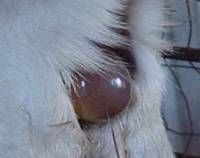
Outset Sign of Kid
The first real sign nosotros await for is some sign of a kid starting out the vulva. The movie to the bottom shows a unmarried hoof starting to appear. If y'all look closely at the hoof, you lot will be able to tell if the kid will exist coming out front starting time or rear first. If you encounter the top of the hoof, it is head get-go. If yous run into the bottom of the hoof, it is rear first. Both are ok. We desire to go on to observe the progress to ensure the kid continues to movement outward. Don't try to rush in too soon to aid. Sometimes it takes a trivial time for the progress to occur.
Potential Problems
No progress. We volition step in to help by trying to assist by carefully pulling on the leg during labor pushes. If y'all doe is not tame or gentle, this may be hard to practice. If she continues with no progress, someone (vet or you lot if knowledgeable) will need to become inside to determine what is blocking the progress. It is likely that the kid is not positioned correctly as shown to the correct.
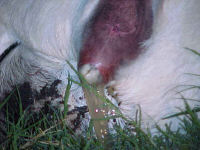
Two legs and a Mouth
The picture in the down shows progress is being made and there are now ii legs and notice that the tip of the rima oris are at the exit. We noticed that both legs are front end legs and the head is in position with the front legs to come up out properly. Equally the head or nose starts to protrude, nosotros watch closely to see if the kid has started to breathe on its own. If it has, nosotros want to ensure that the nose area is cleared of annihilation that may non permit the kid to breathe. Sometimes we have a doe kidding and part of the caput volition start out so as the doe moves around the head will go dorsum in. We will watch closely for continued progress. Many times you will be able to run across the kid'south leg move around showing it is ok.
Potential Issues
-
Once we had two legs come out but 1 was a forepart leg and the other was a rear leg. Information technology turned out that it was twins, with 1 coming head first and the other coming rear start. One leg was from one kid and the rear leg was from the other child. Nosotros had to push button the rear leg back in and feel around for the 2d forepart human foot. We always clothing rubberband gloves for doing this and accept some OB lubrication.
-
Two front legs and no head. The head can be turned to the side and unable to come out. You need to try and right the position of the caput.

Nearly Complete
The hardest role seems to be getting the caput to come out. Later on the head is out, the residual of the body should come out quickly. We step in to check the kid has nothing in the mouth area and clear anything away from the caput. We volition watch for breathing signs and await to ensure the nose area is clear. The child may yet be in the sack and we volition step in to get the kid out of the sack and animate.
Potential Bug
Head and feet come out but no additional progress. Nosotros take had a few kids that got their head and feet out but could non brand any boosted progress. We had to call a vet to deliver the kid. It turned out that the kid's shoulders were hunched frontwards and non positioned to go through the neck area. He had to button the kid partially back in to position the shoulders correctly.
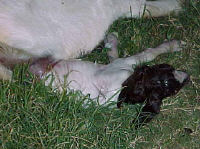
Cleanup
We make sure either the doe starts cleaning up the kid or we volition lay the child in front of the doe to let her to first cleaning upwardly. The doe will nibble at all of the mucus on the kid normally starting at the head. She needs to be able to clean upwardly her kids in order to place with the kid. Cleanup may be interrupted by going into labor again with more kids. We watch closely to ensure she does non lay on a kid already born while she tries to deliver other kids.
Potential Problems
-
Child crawls away from mother while she delivers other kids. The child may get lost for a period and the mother does not get to make clean it upwardly. The mother may non believe it is her child and will reject information technology.
-
Child gets under mom while she is delivering another kid. This can suffocate the kid.
-
New mother may not sympathize what she is expected to do. You may accept to ensure the child's head is cleaned enough for breathing and if the weather is common cold, you may have to towel dry the child to keep it from getting too cold.

Welcome to the Globe
If all goes ok, the kid should kickoff moving effectually trying to stand inside an hour or sooner.
Safe legs. Nosotros take had some kids that could non stand up on their back legs because they were and so rubbery. The volition normally correct itself inside a week. You demand to ensure the child is getting the needed nutrition until they tin get effectually on their own.
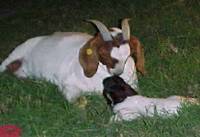
Side by side Solar day and Success
This was the beginning time this doe had kidded and she only had 1 child. It was a buck kid. The doe is out of Magnum's Dazzler, a Magnum daughter and was bred to Winchester, a total brother to Magnum. The little boy is named son of a gun.
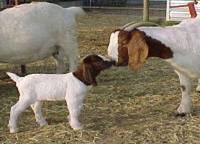
Start two hours
-
If the mother kidded outside and it is cool atmospheric condition, we will move mom and kids into our barn with a clean pen, fresh water and food.
-
As soon as the mother has cleaned the kids, we will requite them some Nutra-Drench for temporary energy
-
Side by side nosotros will trim the umbilical cord to i inch and apply 7% Iodine to the navel to prevent infection
-
We will bank check the female parent'southward teats for milk. At that place may be some wax in the tips that need to be removed to allow milk to menstruation.
-
We will monitor the kids while they effort to nurse on their ain for nigh 90 minutes. The faster they get their mother's colostrum, the better their futurity health will be.
-
If they accept not nursed on their own in the xc infinitesimal timeframe, we will try to help them nurse from their mother. We desire the kids to nurse on their own if possible.
-
If they cannot or will not nurse on their own within the ninety minutes, nosotros will milk some colostrum into a glass jar and feed the kids with a bottle or drench with a syringe.
-
Once the kids have had some colostrum, we will give them 2cc of Bar Guard 99.
-
Subsequently the kids take had colostrum and the Bar Baby-sit 99, we will put them in a small doghouse blazon of shelter in the pen with the mother. They can wander in and out only we desire them to have some protection from their female parent accidentally laying on them during the first iii days.
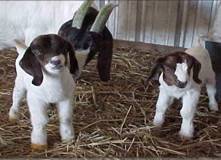
Shedding afterbirth
The mother needs to shed the afterbirth within 24 hours of kidding. Nearly of the fourth dimension, they shed it within hours. If there is some yet hanging after 24 hours, you can try to "gently" pull it out. Some times the "gravity" has not taken effect and a gentle pull will remove the last of it. If you gently pull and it starts to come out without any "resistance", everything is ok. If not, you tin give the doe some Oxytocin. This will assistance the doe shed the afterbirth and help bring in her milk.
Exception:
We apply to think that after a doe shed her afterbirth, she will not have any more than kids at that fourth dimension. We had a doe requite nascency to a single and and then shed her afterbirth four hours afterwards. We expected twins and she however looked like she had another child simply there was no more labor. Nosotros checked on her eight hours later and nil was happening then we assumed she was through. The next forenoon we found another kid dead in the pen. Information technology was the same size and looked good for you. The vet said it can occur and the kid born afterward a doe loses her afterbirth is unremarkably born dead.
Goat diet
More often than not, goat feed nutrients are divided into six groups. Post-obit is a brief discussion of these nutrients:
Protein
Protein is the only nutrient that contains nitrogen. Poly peptide quality - a term referring to the amino acid content - has no significance in ruminant diet, except at exceptionally high levels of milk production. Rumen microorganisms manufacture their ain body poly peptide, consisting of all the necessary amino acids, which are subsequently digested by the host creature.
Protein makes up the bones animal tissue of the body and is vital for growth, milk product, disease resistance, reproduction, and general maintenance. The body has very little if any excess protein. Generally, the nitrogen is eliminated past the kidneys and the residue is burned as free energy. Since protein is generally the about expensive part of the ration, it is costly to feed more than what is needed. Protein requirements vary between 12 and 16 percent of the ration dry affair with the latter needed for high milk production.
Urea and other not poly peptide nitrogen products can be utilized by the microorganisms of the rumen for the production of poly peptide. They are not generally recommended for goats because they are very selective in their diets.
Energy
All discussions of nutrition seem to brainstorm with energy, probably considering this is the all-time defined requirement of farm animals and is expensive. Most of the goat'due south energy comes from the breakup of the fiber of forages, while the remainder comes from the called-for upward of concentrate starches and fats. Over a longer period of time furnishings such as retarded growth, delayed puberty, and decreased fertility will go apparent.
Energy is measured in two different means by the feed industry. The first and more established method is past Total Digestible Nutrients (TDN). As the name suggests, the TDN consists of the sum of the digestible carbohydrates, digestible protein, and digestible fats (multiplied by 2.25 since fats contain that much more than energy than protein or carbohydrates). The TDN organisation takes into consideration just one nutrient loss - feces. For this reason, the cyberspace energy system is gaining in popularity. This system considers energy that is lost in the feces, urine, gases, and the work of digestion. In contempo years this system has been fifty-fifty more than refined to business relationship for varying energy utilization needs for trunk maintenance, weight gain, or milk product.
Minerals
Many minerals are required by the caprine animal. Most can exist obtained from good forage and a regular concentrate mixture. The major minerals of concern are calcium, phosphorus, and common salt, which are usually added to the ration either in the grain mix or by gratis-choice feeding. Goats do not swallow minerals complimentary choice according to their needs. It is, therefore, recommended that minerals be force-fed through the grain mixture or mixed with a succulent feed similar silage or light-green chop, if possible. The ratio of calcium to phosphorus is important and should be kept around ii:1. If these minerals must be fed complimentary-choice, such as to dry goats and yearlings, a expert mixture is one containing equal parts of salt and dicalcium phosphate, or a similar commercial mix.
Vitamins
Vitamins are needed by the trunk in small amounts. Since all the B vitamins and vitamin K are produced in the rumen and vitamin C is manufactured in the trunk tissues, the only vitamins of concern in ruminant nutrition are vitamins A, D, and E. During the late jump, summertime, and early fall the animals can get all they need from green pastures and plenty of sunshine. In addition, they can shop a adept supply of these vitamins to comport them into the winter months.
Nevertheless, it is a skilful idea to add these vitamins at the charge per unit of six million units of vitamin A and 3 million units of vitamin D to each ton of grain mix during the winter months as an added precaution since they are not very expensive.
Fats
Fats are of piddling importance in the ruminant ration. Practically all feeds contain small amounts of fat, and added levels are not practical. A level of 1.5 - ii.v pct in the grain mixture is normal.
Water
This is the least expensive feed ingredient, yet a deficiency will touch milk production more chop-chop than the lack of any other nutrient. Water is not simply the largest single elective of nearly all living plant and animal tissue, merely it also performs exceedingly important functions during digestion, absorption of nutrients, excretion of waste matter products, control of body temperature, and the production of milk. Set up admission to h2o is of import. Goats with water constantly bachelor have been shown to produce more milk than those watered twice daily and over ten percent more those watered only one time per mean solar day.
(Source: www.jackmauldin.com )
© 2009-fifteen TNAU. All Rights Reserved.
Source: https://agritech.tnau.ac.in/animal_husbandry/ani_goat_reproduction.html
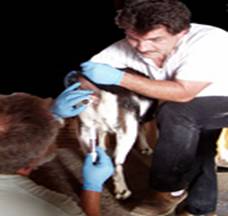
0 Response to "How Do You Know When a Goat Is in Labor"
Post a Comment